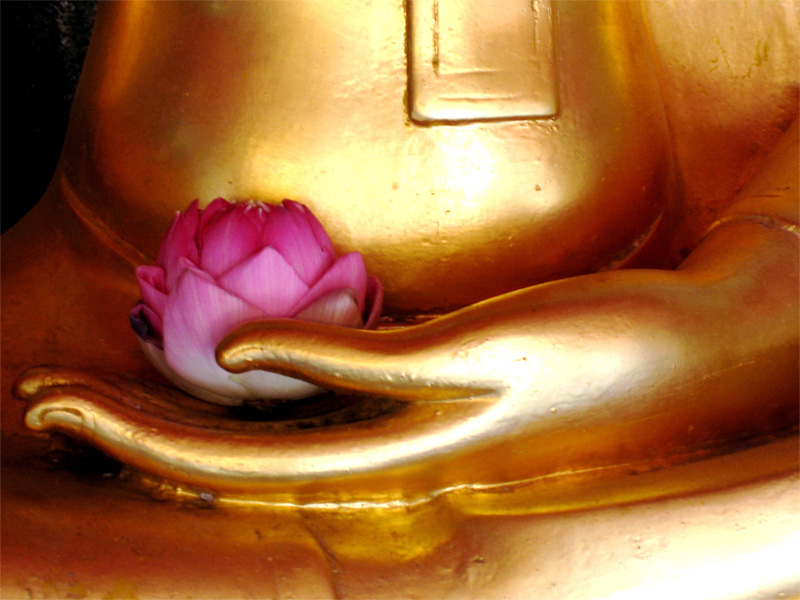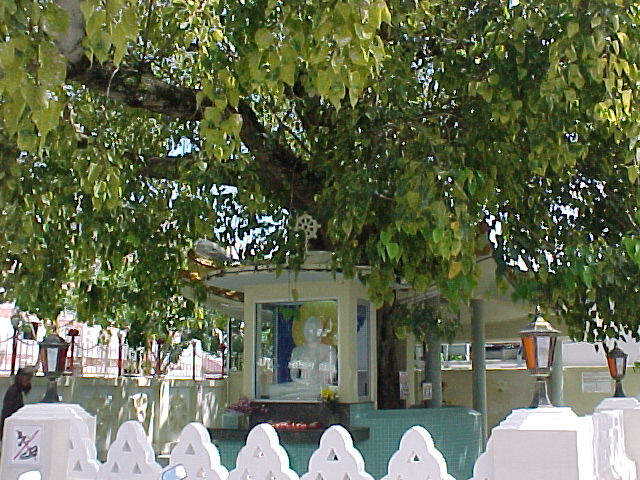 Every minute of every day, while we sit in the relative comfort of our homes, Buddhist monks in Burma are being tortured in prisons. And when they aren't being beaten, they are huddled in dirty, dark and disease ridden cells. All this they endure because they wouldn't sit by and watch the people of Burma be treated like garbage by the dictatorial regime. Their courage was driven, in part, by the deep compassion developed from practicing the Dharma. They are the conscience of the world standing up and saying, "enough!!"
Every minute of every day, while we sit in the relative comfort of our homes, Buddhist monks in Burma are being tortured in prisons. And when they aren't being beaten, they are huddled in dirty, dark and disease ridden cells. All this they endure because they wouldn't sit by and watch the people of Burma be treated like garbage by the dictatorial regime. Their courage was driven, in part, by the deep compassion developed from practicing the Dharma. They are the conscience of the world standing up and saying, "enough!!" Wednesday, November 30, 2011
U.S. Secretary of State Hillary Clinton Visits Burma.
 Every minute of every day, while we sit in the relative comfort of our homes, Buddhist monks in Burma are being tortured in prisons. And when they aren't being beaten, they are huddled in dirty, dark and disease ridden cells. All this they endure because they wouldn't sit by and watch the people of Burma be treated like garbage by the dictatorial regime. Their courage was driven, in part, by the deep compassion developed from practicing the Dharma. They are the conscience of the world standing up and saying, "enough!!"
Every minute of every day, while we sit in the relative comfort of our homes, Buddhist monks in Burma are being tortured in prisons. And when they aren't being beaten, they are huddled in dirty, dark and disease ridden cells. All this they endure because they wouldn't sit by and watch the people of Burma be treated like garbage by the dictatorial regime. Their courage was driven, in part, by the deep compassion developed from practicing the Dharma. They are the conscience of the world standing up and saying, "enough!!" REBIRTH, REVISITED
Let’s see if I have this right. I’m struggling through the first pages of Thanissaro Bhikkhu’s “The Truth of Rebirth.” Like all of Than Geoff’s writing, it is dense with knowledge and profound thought. He writes with great clarity, but his subject matter is not easy to grasp; and I continue to struggle, of course, with my own skepticism.
As I understand it, then, Than Geoff is disputing the easy path of “Buddhism without belief”—the familiar Western choice to embrace Buddhism as no more than essentially a sound guide to a life well lived and a fine model for psychological health. But not as a religion. This is the choice I myself have made, in my reluctance to move beyond reason into faith. I am, I confess, one of those who in Than Geoff’s words “have felt burned or repelled by the faith demands of Western religion” and who “would prefer a Buddhism that makes no faith demands.” Because faith would require that great leap beyond what can be rationally tested and proven into the belief in rebirth.
For Than Geoff, though, this belief is integral to following the Buddhist path. As is his custom, he turns to the Buddha’s words for instruction—or at least those words as they are reported by the followers who first set them down. He cites the three knowledges described by the Buddha in recalling the night of his awakening: the knowledge of “manifold past lives, i.e., one birth, two… five, ten… fifty, a hundred, a thousand, a hundred thousand, may eons of cosmic contraction”; the second knowledge, the “vision of how living beings at large are reborn after death”: and the third, the understanding that the “same causal pattern” of events—karma, then—operates in both the macro experience, life to life over eons of time, and the micro, “events immediately present in his own mind.”
All of which gave rise to the Four Noble Truths, because each life brings with it suffering, and the Buddha’s great teaching and his goal for all living beings was the end of suffering—and the end, then, logically, of the continuing cycle of death and rebirth, the attainment of the “deathless.” (Bear with me, I’m trying to work my way through this…) After identifying the existence and the cause of suffering, and establishing that there is an achievable end to it, the fourth Noble Truth lays out the path to follow if we wish to reach that goal.
Than Geoff argues vigorously—and with meticulously researched scholarship—against the historical revisionism that is used by those who seek to adapt Buddhism to a twenty-first century world by attributing the Buddha’s thoughts on rebirth to a long-discredited, pre-scientific cultural context. He sees the Buddha’s insights as a radical departure from then current thinking, when theories of the after-life were either “annihilationist” or “eternalist.” Much like the atheism of today, annihilationism denied any form of survival after death. In this view, death puts a full stop to everything, body and consciousness alike. Eternalism argued, on the contrary, that some part of our being survives after death, but without agreement as to exactly what. It hinged on “the metaphysics of personal identity”—the definition of what a “person” actually is. Some seemed to propose the existence of that kind of vital essence that Christians today believe in as the “soul”—the tradition in which I myself was raised and have subsequently abandoned.
In this context, the Buddha’s revolutionary contribution was to take the matter out of the power of extra-human hands—whether deities or metaphysical systems—and return it to the individual human being and his actions, thus empowering each of us to take responsibility for our own suffering and its cessation. Knowledge of his own past lives, revealed in the course of his awakening, convinced the Buddha not only of the truth of rebirth, but also of the causal connection between action and its consequence: what was true on the macro level, from life to life over eons of time, was also true of the micro experience of this lifetime: that wholesome, skillful, well-intentioned actions result in greater happiness for myself and others, while thoughtless, unkind, ill-considered actions bring the opposite results.
Once this responsibility is acknowledged, then, the matter of rebirth comes down to a pretty simple proposition. We can choose to either believe in it or reject it. Our choice may be guided by something akin to the famous bet that Blaise Pascal offered in the 17th century on the belief in God: if I choose to believe in the truth of rebirth, the Buddhist bet suggests, my good actions now will assure me a good destination in the “heavenly world.” If there is no world after death, those same good actions will assure me greater happiness and less suffering in this one. If the bet is a win-win, I can only benefit from making the choice to believe. Conversely, I have nothing to gain—and everything to lose—if I refuse it.
So, yes, this remains a leap of faith. The Buddha offers no proof, just the example of his own experience, the challenge to think it through, and a way to go about it. I'll be reading further and reporting further on is challenging and, to me, quite difficult book.
Tuesday, November 29, 2011
MY HEAD
Early Morning Buddhist Inspiration - 11/29/2011
Early Morning Buddhist Inspiration - 11/29/2011
Monday, November 28, 2011
I'M THIINKING...
Early Morning Buddhist Inspiration - 11/28/2011
Early Morning Buddhist Inspiration - 11/28/2011
Sunday, November 27, 2011
Bodhi Day

2,500 years ago, a young prince in Northern India named Siddhartha Gautama sat beneath a fig tree and declared, “Even though the flesh falls from my bones and the bones themselves crack, I will not get up from this seat until I have attained supreme and perfect enlightenment!” This determined young man then faced down all of his inner demons, defying and finally taming all of the temptations and distractions of greed, anger, restlessness, laziness and self-doubt. He finally attained a state of calm awareness. His mind had become like a clear and still pool which could perfectly reflect all things within it.
During the early evening, Siddhartha reflected on all of his former thoughts, words and deeds. He perceived within himself all of the many things that he had done and experienced in both the present lifetime and in all of the innumerable past lifetimes which became known to him in this state of clear calm awareness. He saw that he himself had created the destiny which had brought him to the point where he could sit beneath that tree at that time and to seek the answers to the great question of birth and death.
During the middle of the night, his awareness expanded to include the lives of all sentient beings. He saw that his life was indivisibly involved in the lives of all other beings. He saw how his life effected the lives of all others and how their lives effected his. Furthermore, he perceived that they too were the creators of their own destinies through the consequences of their own actions.
As the morning approached, Siddhartha contemplated the vast network of cause and effect itself. He saw how all beings were intimately connected to one another in this vast network of mutual influence and creation. Like a vast net of jewels reflecting each others' light and beauty he saw how all beings arose as part of an unending process of mutual creation. He also saw how ignorance of the true nature of reality was the cause of all the selfish craving which led to suffering, and he saw that this suffering could be ended through a life based upon the truth, the Wonderful Dharma.
As the morning star appeared in the sky, Siddhartha’s contemplations were fully realized in the fullness of the living moment in which the Wonderful Dharma is expressed. In that moment, Siddhartha became the Buddha, the fully awakened one who realized and could share with others the true nature of reality which could end suffering and open the eyes of all people to the selfless beauty which he had seen and now manifested in his own life.
Like Siddhartha, we too, should find time to calm our hearts and minds and allow ourselves to clearly reflect the true nature of life. We too, should reflect upon our actions and their consequences, so we can humbly take responsibility for our lives. We too, should reflect upon the lessons that the lives of others hold for us, so that we can learn from their mistakes and receive inspiration from their successes. We too, should reflect upon the vast and marvelous workings of the Dharma which pervades our lives and in fact is our life. Above all, however, we should realize that the Dharma, the true nature of reality which is so difficult to perceive and understand, has been given to us by Sakyamuni Buddha. In the Lotus Sutra, Sakyamuni Buddha stated, “For many hundreds of thousands of billions of countless eons, I studied and practiced the Dharma difficult to obtain, and [finally attained] perfect and complete enlightenment. Now I will transmit the Dharma to you.” For Sakyamuni Buddha’s efforts and determination, his great generosity and compassion, and most importantly for his gift of the Dharma which he realized beneath that fig tree 2,500 years ago, we come together today in celebration.


Early Morning Buddhist Inspiration - 11/27/2011
Early Morning Buddhist Inspiration - 11/27/2011
Saturday, November 26, 2011
AFTER-LFE
Friday, November 25, 2011
A LIBERAL SAVIOR?
The key is not just emotional investment in election-year saviors but also an engagement with policy. A commitment to organized expressions of political desire — like those that have been harnessed so effectively in recent years on the right — have been absent for far too long in Democratic politics. Now, with labor protests, campaigns to block voter suppression and personhood measures and the occupations of cities around the nation, there seem to be some small signs that liberals are remembering that politics requires more of them, that they need movements, not just messiahs. But their engagement must deepen, broaden and persist beyond last week’s elections and well beyond next year’s elections if there is any chance for politicians like Warren to succeed.
Because while she might provide her supporters and her constituents a voice that, if properly tuned, will rattle doors that are now gummed shut, what Elizabeth Warren cannot do is fix this mess herself.
The same words, of course, are true of the whole story of President Obama, who has proved--not to my surprise--unable "to fix this mess" himself. Unless and until the support of liberals becomes more unified and less easily distracted into the narrow channels of self-interest and personal issues, we will continue to entrust our future to "saviors''--and will continue to feel let down by them.
Early Morning Buddhist Inspiration - 11/25/2011
Early Morning Buddhist Inspiration - 11/25/2011
Thursday, November 24, 2011
THANKSGIVING






















